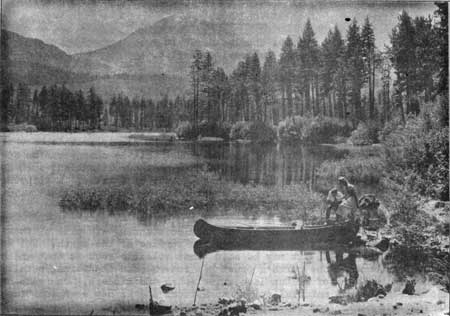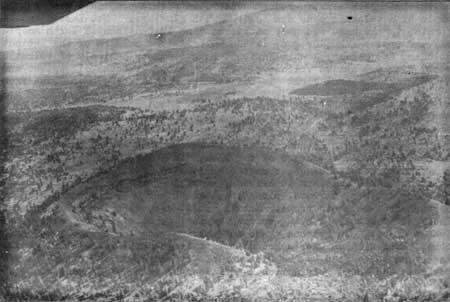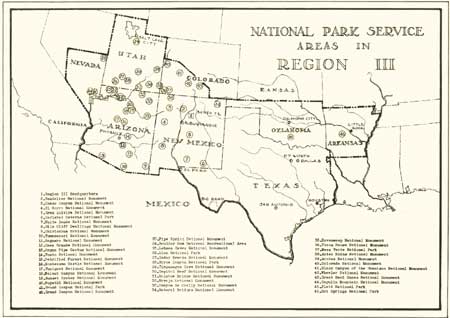|
VOLCANOES
By Dr. Charles N. Gould,
Former Regional Geologist.
We are apt to think of our earth as a stable,
finished, unchangeable body. But such is not the case. The surface of
the earth is in a constant state of change. Mountains rise and fall;
seas are scooped out, deepened, and are again filled; rocks and soil are
washed down the slopes and come to rest in the valleys. But so slowly is
this brought about that in the lifetime of an individual little change
can be noticed. Only the most violent phenomena attract our attention,
such as a destructive flood, which changes the channels of a river; a
slipping along a fault line which causes an earthquake, and perhaps a
tidal wave; a titantic explosion which blows off the top of a
volcano.
Volcanoes constitute one of the most outstanding
examples of those forces that constantly tend to change the surface of
the earth. Not to become too technical, it may be said that volcanic
rock is that which comes from beneath the earth's crust in a superheated
condition, usually either in the form of molten lava or of ashes and
cinders. On reaching the surface, this material cools and hardens and is
now seen sometimes as volcanic cones and sometimes as sheets of basalt
or other similar rock.
In selecting areas of outstanding scientific
interest, the National Park Service has not neglected volcanoes, lava
flows, and other forms of volcanic phenomena. Mount Rainier, in
Washington, is a perfect example of a volcanic cone now covered with
glaciers. Mt. Lassen, California, is the most recently active volcano
in Continental North America; and Crater Lake, Oregon, is the
water-filled caldera of the extinct volcano, Mt. Mazama. Hawaii National
Park consists entirely of volcanic rock, with two active volcanoes. The
hot water at both Yellowstone and Hot Springs National Parks is believed
to be heated by emanations from sub-surface volcanic rocks.
And so with the national monuments. Devil's Tower in
Wyoming, and Devil's Postpile in California, are examples of unusual
forms of volcanic rocks. (His Satanic Majesty is always well served in
the matter of nomenclature.) Craters of the Moon, in Idaho, and Lava
Beds, in California, consist of great masses of jumbled lava rock.
Wheeler, in Colorado, and Chiricahua in Arizona, contain great numbers
of pillars, needles, spires, turrets, pinnacles, and other unique
forms carved by erosion from volcanic rocks. Katmai, in Alaska, with the
Valley of Ten Thousand Smokes, is a dying volcano area. Capulin, in New
Mexico, and Sunset Crater, in Arizona, are outstanding examples of young
volcanic cones, each with an unbreached crater at its summit. The cliff
dwellings, once occupied by the Old People, at Bandelier and Gila, in
New Mexico; and Tonto, in Arizona, are located in caves in volcanic
rock. Grand Canyon National Monument, Arizona, adjacent to
Grand Canyon National Park, contains many examples of young cinder
cones, from some of which lava poured out in such quantities that it
once formed a dam across Grand Canyon. So recently did this volcanic
activity occur that the river has not had time to completely clear its
channel, as is evidenced by a series of rapids in the bottom of the
canyon at the site of the old dam.

MT. LASSEN, CALIFORNIA.
There are a number of areas in the Southwest
containing volcanic rocks that from time to time have been considered
for national monument status. Some of these may be of national monument
calibre, in that the geological features are outstanding. The largest
single area of volcanic rocks in New Mexico is in western Valencia
County, some 100 miles southwest of Albuquerque, and half that distance
southeast of Gallup. Its easiest approach is by way of Grants. The area
is irregular in shape, but approximates 1,000 square miles, being 50
miles long and averaging 20 miles in width. It includes scores of
volcanic cones and craters. From the Oso ridge fire tower, about 3 miles
northwest of the Ice Caves, at an elevation of 9,500 feet, I counted
thrity-two volcanic cones, to the south or southwest. Twelve of these
appeared to be less than 15 miles distant. It is the accumulated
material from these various craters that makes up the malpais rock that
we see today.
Within this mass of volcanic rock there are a number
of ice caves. One of these has been exploited and tourists may now enter
by a wooden stairway. The cave is about 300 yards from a point at the
edge of the malpais which may be reached by a car. A trail has been
broken out, over which it is possible to walk with no great
inconvenience. At the end of the trail one comes abruptly to a sink
hole, or depression, in the lava, approximately 300 feet long, 100 feet
wide, and 40 to 50 feet deep. The sides are precipitous, and the bottom
of the cavity is filled with blocks of broken black basalt. At the
northwest end of the sink-hole is a cave 50 feet below the bottom of
the main channel, and at the bottom of this depression a cave extends
back under the lava for perhaps 100 feet. Along the sides of the
depression I counted seven layers of basalt and cinders in regular
sequence, indicating a number of separate lava flows. The northwest wall
of this lower depression is formed of solid ice. This ice wall is 10 to
12 feet high and 35 feet long. The top is covered with boulders dropped
from the roof.
About 2 miles south of the ice cave there is a
channel more than a mile in length, very similar to the one at the first
cave visited. The width of this channel is about 100 feet and the depth
50 feet. The sides are precipitous. Two natural bridges span
this channel, each about 100 feet wide. In each ease the lava rock which
forms the bridge is 10 to 15 feet thick. Ice is reported in caves at
each end of this channel. Still further south may be found another
series of channels and caves, many of which contain ice. No one seems to
know how many caves there are in these lava beds, but the number will
undoubtedly run into the scores, and possibly into the hundreds.
This lava bed is one of several places in the
Southwest supposed to contain the noted Adams Diggings, which, as a
popular legend, ranks with the Lost Dutchman's mine, in the Superstition
Mountains. So persistent is the belief of vast treasures hidden
somewhere among the lava beds that old prospectors still hunt for it.
The only inhabitants of an area nearly as large as Rhode Island are
wandering prospectors lured ever onward by the hope of hidden wealth.
There is an occasional sheep herder, seeking grass for his flock.
The largest known extinct volcanic crater in the
world is the Jemez Crater, about 40 miles northwest of Santa Fe.
According to Dr. Clarence S. Ross, of the U. S. Geological Survey, this
crater was formed by eruptions on a stupendous scale. It was simply
blasted out of the older volcanic materials. It is 16 to 18 miles in
diameter, over 50 miles in circumference, and 600 to 800 feet deep. The
materials ejected were largely ashes and small rock fragments which were
carried by the wind and deposited along the slope of the volcano. On
compaction, this ashy material became tuff which today forms Pajarito
Plateau, lying between Jemez Crater and the Rio Grande. Some fifty
small streams heading along the outer slope of the crater have cut
deep, steep-sided canyons in the soft tuff. The Old People built their
homes in caves in the walls of these canyons. The cliff dwellings in
Frijoles Canyon, in Bandelier National Monument; and those at Puye,
nearby, are the most noted. On the mesas between the canyons there are
hundreds, perhaps thousands, of ruins built by prehistoric people.

CRATER NEAR GRANTS, NEW MEXICO.
Of the Jemez Crater, Ross says: "This is much the
largest crater known, being even larger than the great Ngorongora Crater
of Africa." He also says: "The great crater is now drained by two
streams which have breached the rim, but within the crater there has
been little erosion. At one time the crater was a great lake." This
lake must have had an area of approximately 150 square miles, or nearly
eight times the area of the present Crater Lake, in Oregon. Within the
crater there are numerous hot mineralized springs, some of which have at
various times been utilized as health resorts. Geologists believe that,
as in the case in Yellowstone, and in Hot Springs, Arkansas, this hot
water is caused by hot subsurface volcanic rock.
The malpais near Carrizozo constitute one of the most
noted lava flows in New Mexico. Tularosa Valley, or Basin, averages 30
miles wide and extends north for nearly 150 miles from near El Paso,
Texas. On the east this valley is bounded by the Sacramento and Sierra
Blanca Mountains, and on the west by a range variously known as
Franklin, Organ, San Andreas, and Oscura. These mountains, which lie
east and west of the basin, rise 2,000 to 4,000 feet above the valley
floor. The White Sands National Monument, south of the center of
Tularosa Basin, and 25 miles north of the monument is the south end of
the malpais.
Students of biology find in the black rocks of the
malpais, substantiation of the theory of protective coloration. The
following paragraphs, from an article entitled, "In Black and
White", by John Eric Hill, Assistant Curator of Mammals, American Museum
of Natural History, are quoted with permission, from the March, 1939,
issue of Natural History:
"In the Tularosa Valley, in southern New Mexico,
there are two unusual environments situated close to each other, a
black lava flow and an area of white sand dunes, each with mammals that
blend with their respective backgrounds in color. The most interesting
are black pocket mice and white ones, members of a southwestern
American family, intermediate between the squirrels and the mice
proper, having fur-lined cheek pouches and peculiar teeth.
"The lava bed or malpais is about 40 miles long by
two to five miles wide. Most of this lava is probably not over a few
thousand years old and very little weathered. The surface is
unbelievably rough and broken up; there are piles of lava blocks,
fissures, wells and dykes. The bubbling and swirling of molten lava is
congealed, and reminds one of the inferno it was when it poured from
the crater. Progress on such terrain is slow and often painful. Footing
is insecure on the balancing blocks, and the jagged lava cuts and
abrades leather boots in unbelievably short time.
"The crevices and cracks of the malpais form, the
only shelter of the mammals, for the material is hard as east iron. In
the crannies the windborne dust and weathered lava collect and offer
soil for an abundant and varied flora.
"Peculiar animals of the lava beds are a blackish
rock squirrel, black pocket mice, blackish big-eared mice and black wood
rats. The malpais pocket mice belong to a rock-dwelling species,
Perognathus intermedius. Normally this species is grayish
brown, but the race from the black malpais is uniformly blackish, almost
matching the malpais in color. The other dark mammals show a wide range
of variability, from slightly darker than normal to almost black. All of
the dark mammals have normally colored relatives in the mountain sides
and on the rocky buttes which occur in the northern half of the
valley."
One of the outstanding areas in the Southwest.
exemplifying volcanic activity is in northern Arizona, situated chiefly
north of the main line of the Santa Fe Railroad and south of Grand
Canyon. An area of approximately 1,500 square miles is covered with
volcanic rock. During late geologic time this material was brought to
the surface, chiefly in the form of molten lava, which on cooling formed
the hard rock we see today. More than 200 volcanic cones, large and
small, are known to exist in this area. The dominant feature is San
Francisco Peak, the highest point in Arizona, the summit of which stands
at an elevation of 12,611 feet above sea level and approximately 5,500
feet above the surrounding plain. Basalt is the most common volcanic
rock in the area. Near the summit are evidences of glaciation, this
being one of the southernmost glaciers of the great ice age in North
America.
At Sunset Crater National Monument, it has been found
possible to determine the date of the volcanic activity. At the time of
the founding of this crater, the area was already occupied by
prehistoric people and their homes were destroyed by the lava. By the
tree-ring method it has been determined that the eruption occurred
during the last quarter of the ninth century, A. D. It is believed that
Sunset represents the most recent volcanic activity in the San Francisco
area. Sunset Peak is but one of the peaks there. A number of others are
higher, and in many ways equally spectacular. Sunset Crater is a perfect
example of a volcanic cone. It rises to a height of approximately 1,000
feet above its base. At the summit is an unbreached crater 400 feet deep
and a quarter of a mile in diameter. The sides of the cone are composed
of fragments of black volcanic rock which even yet roll down the slope.
The name "Sunset" is from the vari-colored rocks near the summit, where
the color grades downward through different shades of yellow, orange,
red and brown, into the black material on the lower slopes.
In many ways Sunset Crater reminds one of Capulin
Peak, in Capulin Mountain National Monument. Both are typical cinder
cones. Both are located in a region of intense volcanic activity. Both
have craters at the top. The ejecta from both cones is quite similar.
Sunset is the larger cone but Capulin, because of its isolated location,
is perhaps more spectacular. Both mountains are very young geologically,
and owe their perfect shapes to the fact that so short a period of time
has elapsed since the cones were formed, that erosion has not had time
to destroy the symmetry.
To summarize: Taken in connection with Grand Canyon,
San Francisco peaks exemplify the greater part of the story of earth's
history. In Grand Canyon the rocks of the first three chapters are
shown. Rocks of the fourth chapter - the age of dinosaurs - are buried
beneath the lava of the mountains. The volcanoes were formed during the
fifth and last chapter of geologic time, the Cenozoic age. It should be
remembered that this is the classic area selected fifty years ago by Dr.
C. Hart Merriam to exemplify the life zones in North America. From the
bottom of Grand Canyon to the top of San Francisco peaks, a difference
in elevation of over 10,000 feet, one passes successively through the
following life zones: Lower Sonoran, Upper Sonoran, Transition,
Canadian, Hudsonian, and Arctic-Alpine.

National Park Service Areas in Region III.
(click on image for an enlargement in a new window)
|

